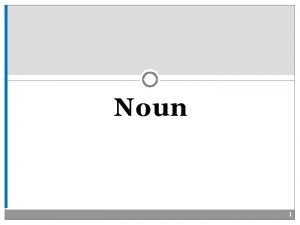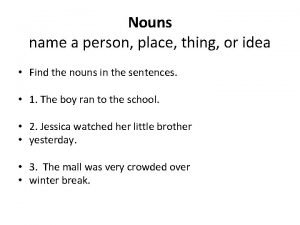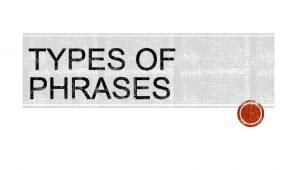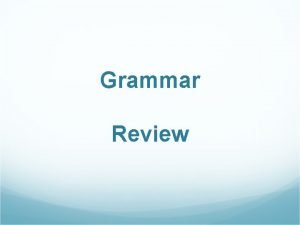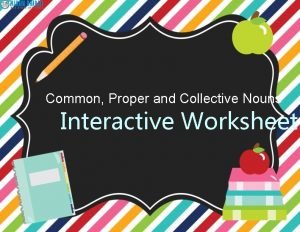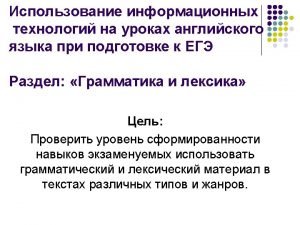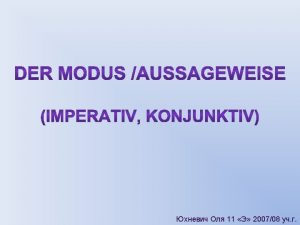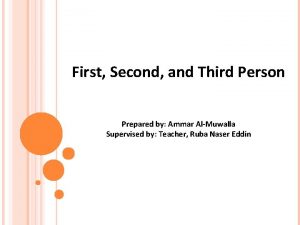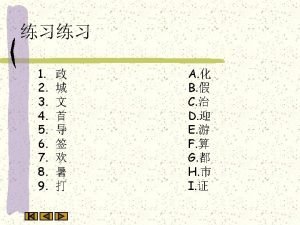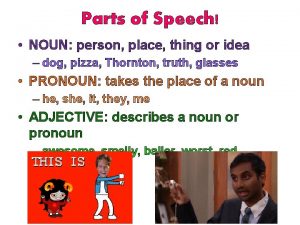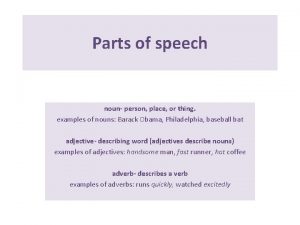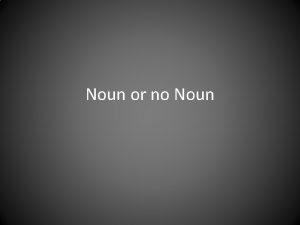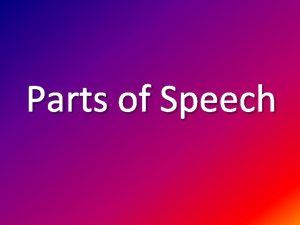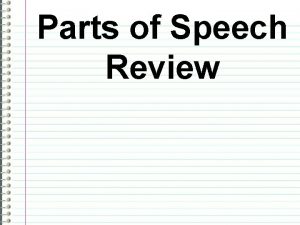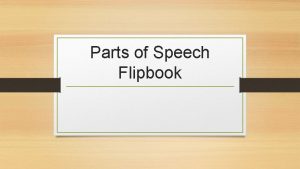Parts Of Speech Noun Person Place Thing or











- Slides: 11

Parts Of Speech Noun = Person, Place, Thing, or Idea. Pronoun = Used in place of a noun. Verb = The action or state of being of a sentence. Preposition = A position word that shows the relationship of two other words in the sentence. Adjective = Describes nouns and pronouns. Adverb = Describes verbs and modifiers. Conjunction = Joins words, phrases, and clauses together. Interjection = Word that shows strong feeling or emotion.

The Case Of The Noun Sentence = Our basic unit of conversation. It takes 3 things to make a sentence. a. Subject = Who or what the sentence is talking about b. Verb = Tells the action of the sentence or links the subject to a word that tells about the condition of the subject. c. A complete thought. ex. By the side of the road. Joe stood by the side of the road. Noun = A person, place, thing, or idea. Case = The way a word is used in a sentence. (ITS FUNCTION) Fundamental Rule of Grammar = The way a word functions in a sentence determines its part of speech, not the word itself. ex. Coffee = What part of speech is coffee. The only sure way to tell what part of speech a word is used as is to see how it’s used in a sentence. Ex. A truck sped past us. Truck tires are larger than car tires.

Ways Nouns Function • • Subject (S)= Usually comes at the beginning of the sentence and is who or what the sentence is talking about. S + V ex. Jim laughed. Direct Object (DO) = Usually follows the action verb and receives the action of that verb from the subject. S + AV+ DO ex. Candy found a quarter. Indirect Object (IO)= Comes in between the action verb and the direct object and tells to whom or for whom the action was done. S + AV+ IO + DO ex. Tim gave Jill a flower. Predicate Nominative (PN)= Follows a linking verb and renames the subject. (Gives another name for the subject. ) S + LV + PN. ex. Savannah is our best student. ***Not all words that follow linking verbs are PN’s. Sometimes the word following a linking verb describes the subject. It is a Predicate Adjective. ex. Savannah is usually happy.

Ways Nouns Function (Continued) • • Object of a Preposition (OP) = First noun after a preposition. It is used with a preposition to make a prepositional phrase. ex. We went (to the store). Appositive (App) = Directly follows any other noun and renames it. Usually set off by a comma or commas. S (App. ) + V + DO (App. ) ex. Joe, my friend, cleaned his rifle, a trusty weapon. Direct Address (DA) = When speaking to someone, the word used to address them is a direct address. ( A direct address can only function as a direct address; it can never be the subject of the sentence. ) Can come anywhere in the sentence. Always set off by a comma or commas. ex. Jill, shut the door. I think, Ted, that you made a mistake. Please try to listen, fellas. Objective Complement (OC) = Only in sentences where the verb means “to make” or “to consider”, it follows the direct object and helps complete its meaning. Can be a noun (OCN) or an adjective (OCA). ex. You make me happy. We elected Tina president.

Steps Used in Breaking Down a Sentence • • • 1. Find the verb. and label it 2. Find and eliminate all prepositional phrases. 3. Find the subject. 4. If the sentence has an action verb, look for a direct object. 5. If the sentence has a direct object, look for an indirect object. 6. If the sentence has a linking verb, look for a Predicate Noun or Predicate Adjective. • 7. Look for Appositives and Direct Addresses • 8. Fill in the rest of the sentence.

Linking Verbs Be Verbs Can be Action or Linking Verbs is am are was were be being been appear become look grow feel remain sound stay taste seem smell Action when they tell the function of the subject. Linking when they tell the condition of the subject. Jim tasted the fruit. Does tasted tell what Jim did or does it tell his condition? The fruit tasted sweet. Does tasted tell what the fruit did or does it tell its condition?

Helping Verbs • Be Verb Helpers • • Is Am Are Was Were Be Being Been Regular Helping Verbs have had do does did shall will should would may might must can could

Prepositions • Common Prepositions aboard, about, above, across, after, against, along, among, around, as, at, before, behind, below, beneath, besides, between, beyond, but, by, concerning, considering, despite, down, during, except, following, for from, inside, into, like, near, off, onto, outside, over, past, regarding, since, than, throughout, till, toward, towards, underneath, unlike, until, upon, within, without. Compound Prepositions according to, ahead of, apart from, because of, by means of, by way of, in front of, in back of, in regard to, in reference to, in spite of, instead of, on account of, on top of, out of, up to, with respect to,

Formulas (How to Break Down a Sentence) • Action Verb = Say what did or what does the subject do. Ex. The soldiers trudged through the mud. What did they do? • • • Linking Verb = No formula. Have to memorize them. Subject = Say who or what; then say the verb. Object of a Preposition = Say the preposition; then say who or what. Direct Object = Say the subject and action verb; then say who or what. Indirect Object = Say the subject, verb, and DO; then say to whom or for whom. Predicate Noun = Say the subject and linking verb; then say who or what. Objective Complement = Say S + AV + DO; then say to be who or to be what. Appositive = No formula. Look for position in sentence. Direct Address = No formula. Look for position in sentence.

Using The Formulas • Subject = Ex. During the night, many owls roosted in our barn. Who roosted or what roosted? Ex. There goes my friends. Who goes or what goes? • Object Of Preposition = (look at example above) During what? In What? • Direct Object = Ex. I take pictures at the game. I take who or what? Slowly, he entered the deserted building. He entered what? • Indirect Object = Ex. After the game Jim gave his girlfriend a hug. Jim gave who or what? Jim gave girlfriend who or what? • Predicate Nominative or Predicate Noun = Ex. Since the quake we have been nervous. We have been who or what? (Now use the “A” test. You are my best friend. You are what? • Objective Complement = They sure make me edgy! They make me to be who or to be what? (Now give edgy the “A” test to see if it is an OCN or an OCA).

Test To Tell If a Word is a Noun or Adjective (“A Test”) • Put A, An, or The in front of the word in question, If the phrase makes sense, the word is probably a PN; If the phrase sounds awkward, the word is probably a PA. Ex. Phil was our best player last year. He is a player. (PN) Phil was rather lazy during summer. He is a lazy. (PA) Sally was an agent of the firm. She is an agent. (PN) Sally was energetic at the party. She is an energetic. (PA)
 Person place thing or idea examples
Person place thing or idea examples Person place thing idea
Person place thing idea Names a person, place, thing, or idea
Names a person, place, thing, or idea Identifying noun phrases
Identifying noun phrases Main idea noun
Main idea noun A noun is a person place or thing
A noun is a person place or thing Nouns person place or thing
Nouns person place or thing Takes the place of a noun or noun phrase
Takes the place of a noun or noun phrase Collective noun of cereal
Collective noun of cereal Complete the table verb noun damage
Complete the table verb noun damage 1.person singular
1.person singular What is third person
What is third person

